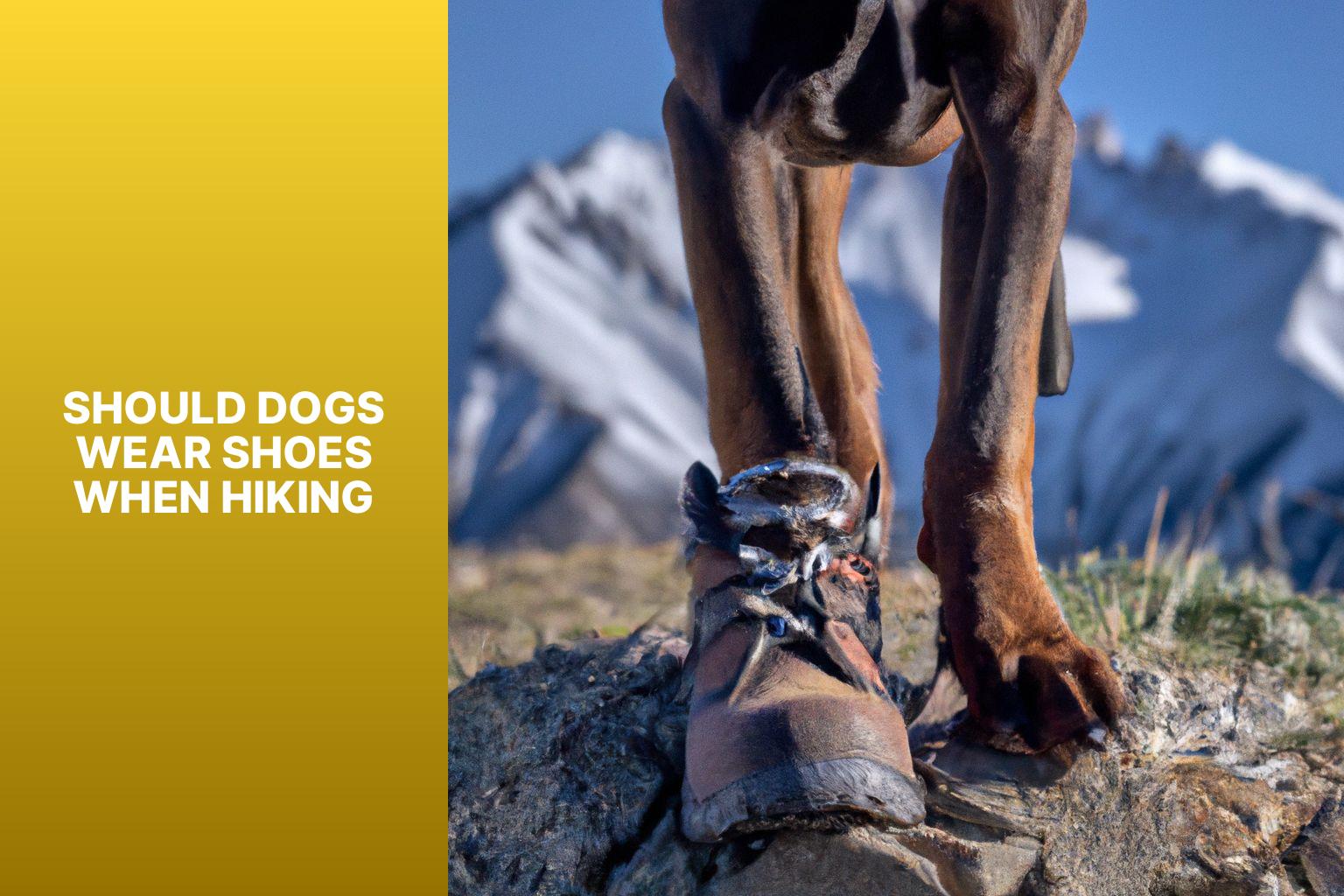Should Dogs Wear Shoes When Hiking
Wearing shoes when hiking is a common practice among humans, but what about our furry companions? Should dogs wear shoes when hiking? This question has sparked a debate among dog owners and outdoor enthusiasts. While there are valid arguments on both sides, it’s essential to weigh the pros and cons to make an informed decision for your canine companion’s well-being.
Examining the benefits of dogs wearing shoes while hiking, it can provide protection against rough terrain, sharp objects, extreme temperatures, and potential injuries. Shoes can enhance traction and stability, especially on slippery surfaces, ensuring your dog maintains a secure footing during the hike.
On the flip side, there are also drawbacks to consider. Some dogs may find it uncomfortable or restrictive to wear shoes, affecting their natural movement and agility. Certain breeds may have thick paw pads that provide adequate protection without the need for shoes. It’s crucial to evaluate your dog’s individual needs and preferences before making a decision.
Determining when dogs should wear shoes while hiking depends on several factors. Consider the duration and intensity of the hike, the terrain, weather conditions, and your dog’s paw sensitivity. Understanding these aspects will help you determine if shoes are necessary for your dog’s comfort and safety during the hike.
Choosing the right shoes for dogs involves considering factors such as material and construction, proper fit and sizing, and additional features suitable for specific trail conditions. The shoes should be made of durable, breathable materials and offer a secure fit without causing discomfort or rubbing.
Training dogs to wear shoes may be necessary, particularly if they are not accustomed to wearing them. Using positive reinforcement techniques and gradually introducing the shoes can help your dog become comfortable and accepting of them before hitting the trails.
Alternatively, if you decide against shoes for your dog, there are alternative methods to protect their feet, such as applying paw balms or using dog booties made of breathable and protective fabrics. These options can provide some level of protection without the need for full shoes.
When hiking with dogs, it’s essential to prioritize their safety. Carry sufficient water and food, check for ticks, be mindful of their exertion levels, and take breaks as needed. Keep an eye on their paw condition throughout the hike and address any signs of discomfort promptly.
Ultimately, the decision of whether dogs should wear shoes while hiking depends on various factors, including their individual needs and the specific hiking conditions. By carefully considering the pros and cons, choosing appropriate footwear, and ensuring their comfort and safety, you can enjoy outdoor adventures with your four-legged friend to the fullest.
Key takeaway:
- Dogs wearing shoes while hiking provides benefits such as protecting their paws from rough terrain and extreme weather conditions.
- Drawbacks of dogs wearing shoes while hiking include the potential discomfort or difficulty in adapting to them.
- Factors to consider when determining if dogs should wear shoes while hiking include the difficulty of the trail, weather conditions, and the individual dog’s paws.
Pros and Cons of Dogs Wearing Shoes While Hiking
When it comes to dogs joining you on a hiking adventure, the question of whether they should wear shoes sparks a lively debate. Today, we’ll dive into the pros and cons of dogs donning footwear on the trails. Discover the benefits that shoes can offer such as protection from sharp objects or extreme temperatures, and the potential drawbacks like restricted sensory experience. Hold on tight as we explore this furry footwear dilemma!
Benefits of Dogs Wearing Shoes While Hiking
It’s important to choose the right shoes for your dog’s needs, ensuring a proper fit. Gradually and positively training dogs to wear shoes can help them become comfortable. Alternative methods like paw wax or balms can also protect dogs’ feet. Remember, assess the hiking conditions, terrain, and your dog’s comfort level before deciding whether they should wear shoes. Consulting with a veterinarian or professional dog trainer can provide guidance on the best approach for your furry hiking companion.
Drawbacks of Dogs Wearing Shoes While Hiking
When dogs wear shoes while hiking, there are potential drawbacks to consider. Here are a few to keep in mind:
1. Decreased Sensory Perception: Dogs rely on touch to navigate and adapt to different terrains. Wearing shoes can reduce their ability to feel the ground, leading to a loss of sensory perception.
2. Overheating: Dogs regulate body temperature through their paw pads, which release heat. Wearing shoes can hinder this process and potentially cause overheating, especially in hot weather.
3. Restricted Natural Movements: Dogs’ paws naturally flex and extend while walking and running. Shoes can limit this movement, potentially leading to discomfort or altered gait patterns.
4. Foreign Object Entrapment: Wearing shoes can protect paws from sharp objects but can also trap debris inside, causing discomfort or injury. Regular checks and cleaning of shoes are necessary.
5. Training Challenges: Some dogs may resist or feel uncomfortable wearing shoes initially. Proper training is needed to ensure they are comfortable throughout the hike.
Considering these drawbacks, it is important to make an informed decision about whether your dog really needs to wear shoes while hiking. Assess the terrain, weather conditions, and your dog’s needs to determine if shoes are necessary. Consulting with a veterinarian or professional dog trainer can provide further guidance. Remember, prioritize the well-being and comfort of your furry companion during outdoor adventures.
When Should Dogs Wear Shoes While Hiking?
When it comes to hiking with our furry friends, one question arises: when should dogs wear shoes? In this section, we’ll explore the factors to consider when deciding whether or not to outfit our canine companions with hiking shoes. From terrain conditions to paw protection, we’ll uncover the key points that can help us make an informed choice for our hiking adventures with dogs. So, let’s dig in and find out when it’s time for those paws to don some stylish footwear!
Factors to Consider
When deciding if dogs should wear shoes while hiking, consider these factors:
- Terrain: The type of terrain determines if your dog needs shoes. Rough, rocky surfaces can cause discomfort and injuries. Softer, well-maintained trails may not require hiking shoes.
- Weather conditions: Extreme heat or cold can damage your dog’s paws. Shoes protect from scorching surfaces and provide insulation.
- Paw sensitivity: If your dog has sensitive or easily irritated paws, shoes can prevent discomfort and provide protection.
- Activity level: Active dogs benefit from shoes to add stability and prevent injuries during running or jumping.
- Size and breed: Smaller dogs with delicate paws may need more protection. Larger, rugged breeds can handle harsh terrains without shoes.
By considering these factors, you can decide if your dog should wear shoes while hiking. Prioritize your dog’s comfort and well-being for a safe and enjoyable hiking experience.
The use of shoes for dogs while hiking has been debated among pet owners and professionals. Factors like terrain, weather, paw sensitivity, activity level, size, and breed determine if dogs need shoes. Advances in shoe technology have led to specific designs for dogs, providing protection, comfort, and stability. Training dogs to wear shoes is important for outdoor activities to protect their paws. Alternatives like paw balms and booties have also gained popularity. Ongoing research and technology advancements prioritize the well-being and safety of dogs while hiking.
Choosing the Right Shoes for Dogs
When it comes to taking our beloved furry friends on a hiking adventure, we want to make sure their paws are protected every step of the way. In this section, we’ll dive into the essential factors to consider when choosing the right shoes for dogs. From the right materials and construction to ensure durability, to finding the perfect fit and sizing for optimal comfort, and even exploring additional features tailored for various trail conditions, we’ll make sure our four-legged companions are ready to conquer the great outdoors.
Material and Construction
When considering material and construction for dog shoes, there are several options available to meet different needs and preferences.
Neoprene is a common material for dog shoes. It offers flexibility, comfort, and protection against hazards on the trail.
Rubber is another popular choice due to its durability and protection. It provides a secure grip and protects paws from sharp objects.
Mesh shoes are ideal for warm climates as they offer breathability and prevent overheating. They are lightweight, promoting agility and ease of movement.
Nylon shoes are known for their strength and resistance. They are suitable for rugged terrains and provide stability and support.
Synthetic leather shoes combine protection and flexibility. They offer durability and are often water-resistant, making them suitable for wet environments.
When choosing material and construction for dog shoes, consider the specific needs of your dog and the hiking conditions. Factors such as terrain, weather, and hike length should be taken into account to ensure you select shoes that will provide optimal comfort and protection for your furry companion.
Proper Fit and Sizing
Proper fit and sizing are important factors to consider when choosing hiking shoes for dogs. To ensure maximum protection and comfort, it is crucial to make sure that the shoes fit correctly.
To determine the appropriate shoe size, accurately measure the length and width of your dog’s paws. Dogs’ paws can vary in shape and size, so trying different sizes is recommended in order to find the perfect fit. Pay close attention to the width and depth of the shoes to ensure a snug and comfortable fit.
Consider looking for shoes with adjustable straps or fastenings that can be tightened or loosened. This feature allows for a secure fit and flexibility during long hikes.
After putting the shoes on your dog, observe how they walk and move. It is important to ensure that the shoes do not hinder their natural gait or cause discomfort or irritation.
During your observation, watch for any signs of discomfort or irritation. If your dog constantly tries to remove the shoes or shows signs of distress, it may indicate that the shoes are not the right fit.
Proper fit and sizing are essential to provide the necessary protection and comfort for your dog’s paws while hiking. By taking accurate measurements and trying different sizes, you will be able to find the perfect fit.
Fun fact: Dogs have sweat glands in their paws, which help them regulate their body temperature during physical activity.
Additional Features for Trail Conditions
Features for Trail Conditions: Additional Features for Trail Conditions
When choosing shoes for dogs while hiking, it is important to consider the following additional features for their comfort and safety on the trail:
1. Traction: Look for shoes with a durable sole and good traction to prevent slips and falls on uneven or slippery surfaces.
2. Waterproofing: Choose shoes made from waterproof materials to keep your dog’s paws dry in wet or muddy conditions. This will reduce the risk of discomfort and foot infections.
3. Breathability: Look for breathable shoes that allow proper airflow. This will prevent excessive sweating and discomfort, especially in hot weather or during intense physical activity.
4. Reflective Materials: Consider shoes with reflective materials or built-in reflectors to enhance visibility in low-light conditions. This will ensure that your dog is visible and safe, particularly during dawn or dusk hikes.
5. Easy On/Off Design: Opt for shoes that are easy to put on and take off. This will save you time and frustration, while also ensuring a secure fit for your dog.
6. Adjustable Straps: Shoes with adjustable straps provide a customized fit for your dog’s paws. This ensures that they stay securely in place during hikes. This feature allows for adjustments to accommodate swelling or changes in paw size during long hikes.
Remember, not all dogs require shoes while hiking. It is important to evaluate the trail conditions and your dog’s needs before making a decision. By considering these additional features, you can choose the right shoes to protect your furry friend’s paws and enhance their hiking experience.
How to Train Dogs to Wear Shoes
Training dogs to wear shoes is beneficial for foot protection and overall safety. Here is a step-by-step guide on how to train dogs to wear shoes:
1. Introduce the shoes gradually: Place the shoes near your dog and allow them to sniff and investigate. This will help reduce any fear or hesitation they may have.
2. Use positive reinforcement: Whenever your dog shows interest in or interacts with the shoes, reward them with treats and praise. This will create a positive association with wearing shoes.
3. Put shoes on paws one at a time: Gently place one shoe on your dog’s paw and give them praise and treats. Repeat this process for each paw, ensuring a comfortable fit and making adjustments if necessary.
4. Start with short sessions: Begin with short training sessions to slowly increase your dog’s tolerance for wearing shoes. Gradually increase the duration over time.
5. Walk with shoes: Once your dog is comfortable wearing the shoes, take them for short walks in familiar environments. This will allow them to become accustomed to wearing shoes and you can observe their gait and comfort level.
6. Monitor and adjust: Pay close attention to your dog’s behavior and make any necessary adjustments to ensure the shoes do not cause any discomfort. It is important to ensure a proper and comfortable fit.
7. Be consistent and patient: Training dogs to wear shoes takes time and patience. Practice and reinforce positive behavior consistently to help your dogs become accustomed to wearing shoes for outdoor activities like hiking.
By following these steps, you can successfully train your dogs to wear shoes and provide them with the necessary foot protection and safety.
Alternatives to Shoes for Protecting Dogs’ Feet
When it comes to protecting dogs’ feet while hiking, there are alternatives to traditional shoes that can keep their paws safe and comfortable. Options include: booties, paw wax, paw balms, and socks.
Dog booties are a popular choice for protecting dogs’ feet from rough terrain, sharp objects, and extreme temperatures. They come in different sizes and styles to fit different breeds and activities.
Paw wax is a balm that can be applied to a dog’s paws to create a protective barrier. It prevents cracking, chapping, and burning, making it a great alternative to shoes in mild conditions.
Paw balms, like paw wax, soothe and protect a dog’s paws. They moisturize and maintain the paw’s natural elasticity.
Dog socks with rubberized grips on the bottom provide traction on slippery surfaces and protection against small rocks and debris.
In a similar scenario, my friend’s dog, Max, loves hiking. One day, they tried a new trail with rocky terrain. Max didn’t have his usual booties, but his owner applied paw wax. Max effortlessly navigated the rough terrain without discomfort. His owner was amazed at how well the paw wax worked. From that day on, they always applied paw wax before hikes, giving Max the protection he needed without shoes.
Tips for Hiking Safely with Dogs

Photo Credits: Jasonexplorer.Com by Samuel Ramirez
Tips for Hiking Safely with Dogs
When hiking with dogs, prioritize safety for both you and your furry companion. Here are some tips for a safe and enjoyable hiking experience:
- Prepare your dog physically: Ensure your dog is physically fit before hiking. Gradually increase their walks to build up stamina.
- Check trail regulations: Research and choose dog-friendly trails. Look for leash requirements and specific rules for dogs.
- Bring essential gear: Pack a leash, collar with ID tags, poop bags, and a first aid kit. Consider bringing a portable water bowl and enough water for both you and your dog.
- Protect your dog from ticks and fleas: Use prevention products to keep your dog safe from pests commonly found in wooded areas. Check for ticks after the hike.
- Train your dog for off-leash hikes: Ensure your dog has reliable recall and behaves well around others.
- Be aware of your dog’s limits: Dogs can overexert themselves, especially in hot weather. Watch for signs of fatigue or overheating.
- Practice Leave No Trace principles: Pick up after your dog and stick to designated trails to avoid damaging vegetation and wildlife.
Remember, hiking with your dog can be a wonderful bonding experience. Follow these tips to create cherished memories on the trails.
Did you know that hiking with dogs can improve both your mental and physical health? Spending time outdoors with your dog reduces stress levels and increases physical activity, benefiting both you and your canine companion.
Frequently Asked Questions
Should dogs wear shoes when hiking?
Yes, dogs can benefit from wearing shoes when hiking. Dog shoes provide protection for their paws from thorns, rocks, and sharp objects, reduce blistering and cracking, and offer stability and support.
What should I consider when choosing dog shoes for hiking?
When choosing dog shoes for hiking, look for water-resistant material, durable soles with good traction, and the right size for your dog’s paws. It is also important to consider the overall quality of the product and read customer reviews.
Can dogs wear boots for summer hikes?
Yes, boots can be used for summer hikes to protect a dog’s paws from hot surfaces like pavement and salted roads. Look for boots with breathable materials to prevent moisture and chafing on the paws.
How can I get my dog used to wearing boots?
To help your dog get used to wearing boots, start by covering one paw at a time and gradually increase the number of boots. Take your dog for short walks to allow them to adjust to wearing the boots.
Are boots necessary for all dogs while hiking?
No, boots are not necessary for all dogs while hiking. Some dogs have more sensitive paws than others, and boots may only be needed in extreme instances such as extreme cold/snow, heat and hot surfaces, or sharp and rocky terrain.
What are some recommended dog boot brands for hiking?
Some recommended dog boot brands for hiking include Ruffwear Grip Trex Dog Boots, QUMY Boots, Truelove Boots, Non Stop Dogwear Protector Bootie, and Ultra Paws Durable Dog Boots. These boots offer protection and durability for different hiking conditions.







